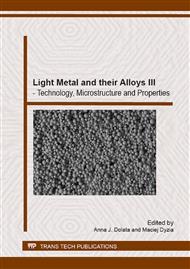p.39
p.47
p.53
p.57
p.65
p.71
p.77
p.83
p.89
The Microstructure of Elektron21 and WE43 Magnesium Casting Alloys after Subsequent Melting Process Operations
Abstract:
Magnesium alloys are one of the lightest structural metallic materials. Their specific strength and stiffness is comparable to this, characterizing aluminum alloys and even some groups of steel and titanium alloys. Their main disadvantage is low maximum working temperature (about 120°C for Mg-Al-Zn alloys). This led to development of Mg-RE-Zr alloys, which can work up to 250°C. The paper presents results of the investigations of influence of subsequent melting operations on the Elektron 21 and WE43 magnesium alloys. Elektron 21 alloy had been prepared from the pure ingots, while WE43 alloy from the scrap material. Average area of the grain flat section and eutectics volume fraction had been evaluated quantitatively. The results of the evaluation have been verified by means of Mann-Whitney U-Test and Kolmogorov-Smirnov statistical tests. The liquid metal treatment led to refinement of the grain only in Elektron 21 alloy (from Ᾱ=3559μm2 to Ᾱ=1849 μm2). Multiple modification of the WE43 alloy does not lead to further decrease of the average area of grain flat section (from Ᾱ=1638μm2 to Ᾱ=1871 μm2).
Info:
Periodical:
Pages:
65-70
Citation:
Online since:
November 2013
Authors:
Price:
Сopyright:
© 2014 Trans Tech Publications Ltd. All Rights Reserved
Share:
Citation:


